Irish vs Bhutanese Community Comparison
COMPARE
Irish
Bhutanese
Social Comparison
Social Comparison
Irish
Bhutanese
6,960
SOCIAL INDEX
67.1/ 100
SOCIAL RATING
134th/ 347
SOCIAL RANK
10,144
SOCIAL INDEX
98.9/ 100
SOCIAL RATING
3rd/ 347
SOCIAL RANK
Bhutanese Integration in Irish Communities
The statistical analysis conducted on geographies consisting of 446,130,960 people shows a substantial negative correlation between the proportion of Bhutanese within Irish communities in the United States with a correlation coefficient (R) of -0.561. On average, for every 1% (one percent) increase in Irish within a typical geography, there is a decrease of 0.011% in Bhutanese. To illustrate, in a geography comprising of 100,000 individuals, a rise of 1,000 Irish corresponds to a decrease of 10.8 Bhutanese.
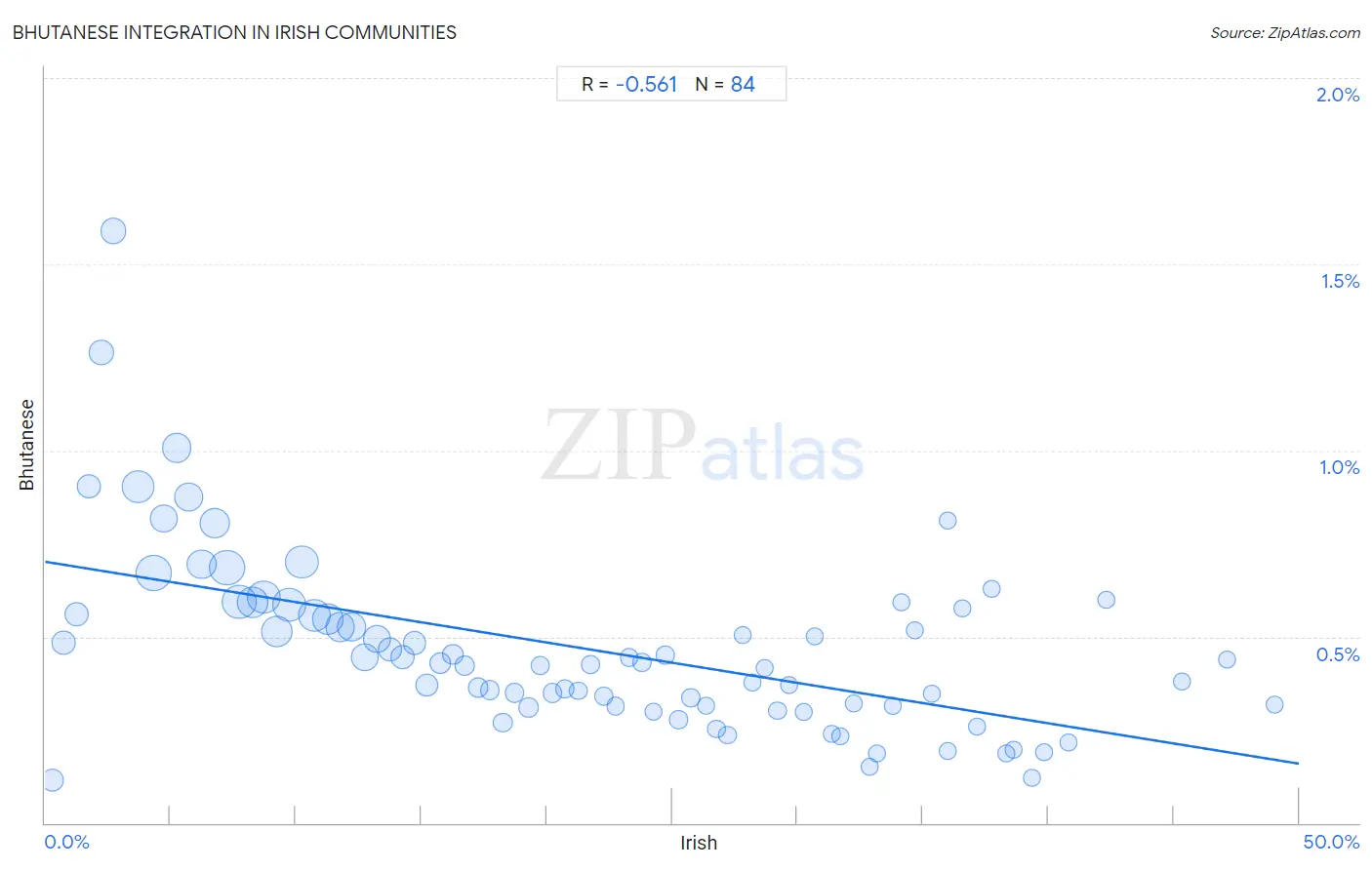
Irish vs Bhutanese Income
When considering income, the most significant differences between Irish and Bhutanese communities in the United States are seen in householder income over 65 years ($61,097 compared to $72,288, a difference of 18.3%), median household income ($86,145 compared to $100,151, a difference of 16.3%), and householder income ages 45 - 64 years ($103,067 compared to $117,750, a difference of 14.2%). Conversely, both communities are more comparable in terms of wage/income gap (28.5% compared to 27.0%, a difference of 5.5%), median male earnings ($56,464 compared to $61,759, a difference of 9.4%), and median earnings ($47,276 compared to $52,297, a difference of 10.6%).

| Income Metric | Irish | Bhutanese |
| Per Capita Income | Good $44,679 | Exceptional $49,894 |
| Median Family Income | Excellent $105,453 | Exceptional $119,800 |
| Median Household Income | Good $86,145 | Exceptional $100,151 |
| Median Earnings | Good $47,276 | Exceptional $52,297 |
| Median Male Earnings | Excellent $56,464 | Exceptional $61,759 |
| Median Female Earnings | Fair $39,291 | Exceptional $43,648 |
| Householder Age | Under 25 years | Poor $51,317 | Exceptional $57,078 |
| Householder Age | 25 - 44 years | Good $96,730 | Exceptional $109,520 |
| Householder Age | 45 - 64 years | Good $103,067 | Exceptional $117,750 |
| Householder Age | Over 65 years | Average $61,097 | Exceptional $72,288 |
| Wage/Income Gap | Tragic 28.5% | Tragic 27.0% |
Irish vs Bhutanese Poverty
When considering poverty, the most significant differences between Irish and Bhutanese communities in the United States are seen in single male poverty (14.0% compared to 11.1%, a difference of 26.2%), child poverty under the age of 5 (16.8% compared to 13.4%, a difference of 25.9%), and single female poverty (21.4% compared to 17.7%, a difference of 21.1%). Conversely, both communities are more comparable in terms of seniors poverty over the age of 65 (9.3% compared to 9.3%, a difference of 0.62%), seniors poverty over the age of 75 (10.7% compared to 10.6%, a difference of 1.0%), and married-couple family poverty (4.2% compared to 4.1%, a difference of 2.3%).
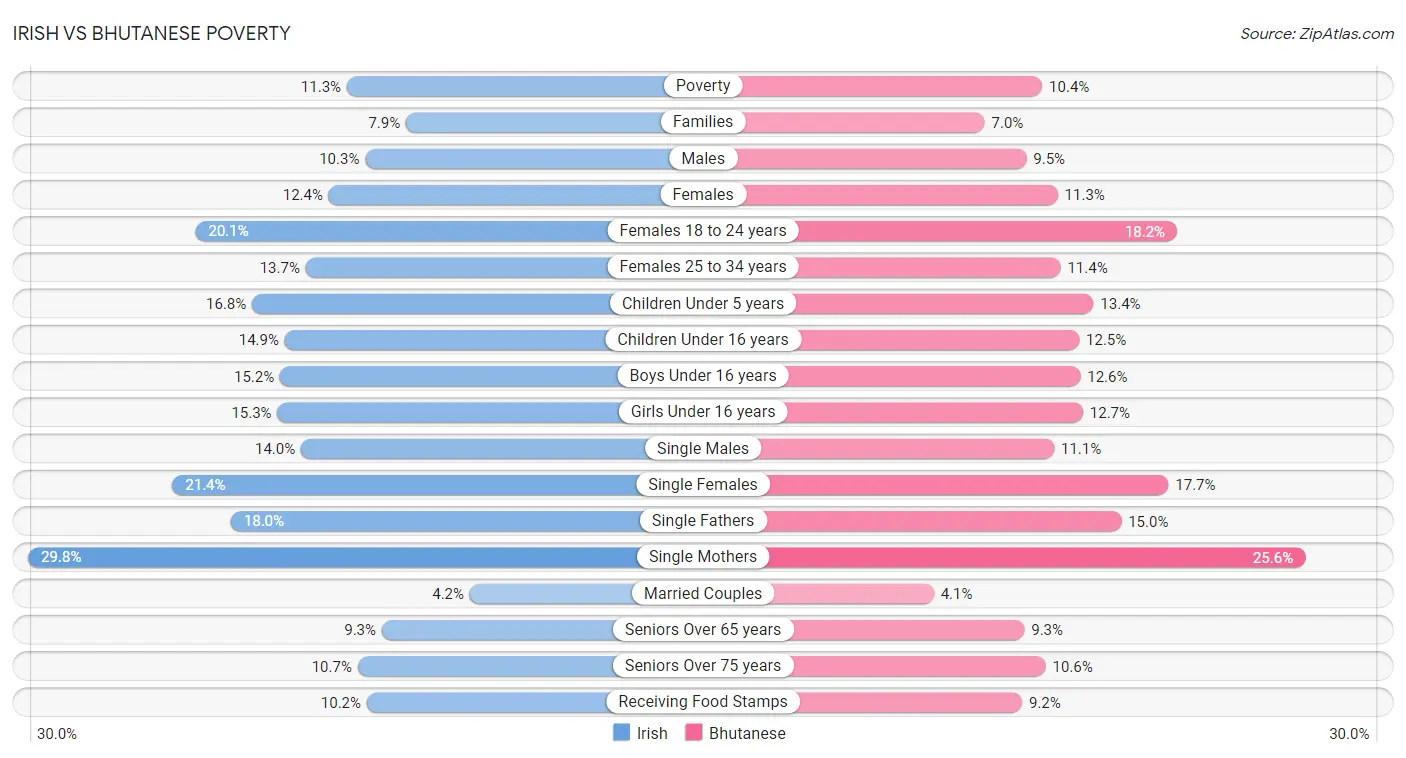
| Poverty Metric | Irish | Bhutanese |
| Poverty | Exceptional 11.3% | Exceptional 10.4% |
| Families | Exceptional 7.9% | Exceptional 7.0% |
| Males | Exceptional 10.3% | Exceptional 9.5% |
| Females | Exceptional 12.4% | Exceptional 11.3% |
| Females 18 to 24 years | Average 20.1% | Exceptional 18.2% |
| Females 25 to 34 years | Fair 13.7% | Exceptional 11.4% |
| Children Under 5 years | Good 16.8% | Exceptional 13.4% |
| Children Under 16 years | Exceptional 14.9% | Exceptional 12.5% |
| Boys Under 16 years | Exceptional 15.2% | Exceptional 12.6% |
| Girls Under 16 years | Exceptional 15.3% | Exceptional 12.7% |
| Single Males | Tragic 14.0% | Exceptional 11.1% |
| Single Females | Fair 21.4% | Exceptional 17.7% |
| Single Fathers | Tragic 18.0% | Exceptional 15.0% |
| Single Mothers | Poor 29.8% | Exceptional 25.6% |
| Married Couples | Exceptional 4.2% | Exceptional 4.1% |
| Seniors Over 65 years | Exceptional 9.3% | Exceptional 9.3% |
| Seniors Over 75 years | Exceptional 10.7% | Exceptional 10.6% |
| Receiving Food Stamps | Exceptional 10.2% | Exceptional 9.2% |
Irish vs Bhutanese Unemployment
When considering unemployment, the most significant differences between Irish and Bhutanese communities in the United States are seen in unemployment among seniors over 75 years (10.2% compared to 8.0%, a difference of 27.1%), unemployment among women with children under 6 years (8.1% compared to 6.7%, a difference of 20.7%), and unemployment among women with children ages 6 to 17 years (9.5% compared to 8.1%, a difference of 18.4%). Conversely, both communities are more comparable in terms of male unemployment (5.0% compared to 4.9%, a difference of 0.16%), unemployment among ages 20 to 24 years (10.0% compared to 10.0%, a difference of 0.62%), and unemployment among ages 16 to 19 years (16.5% compared to 16.4%, a difference of 0.70%).
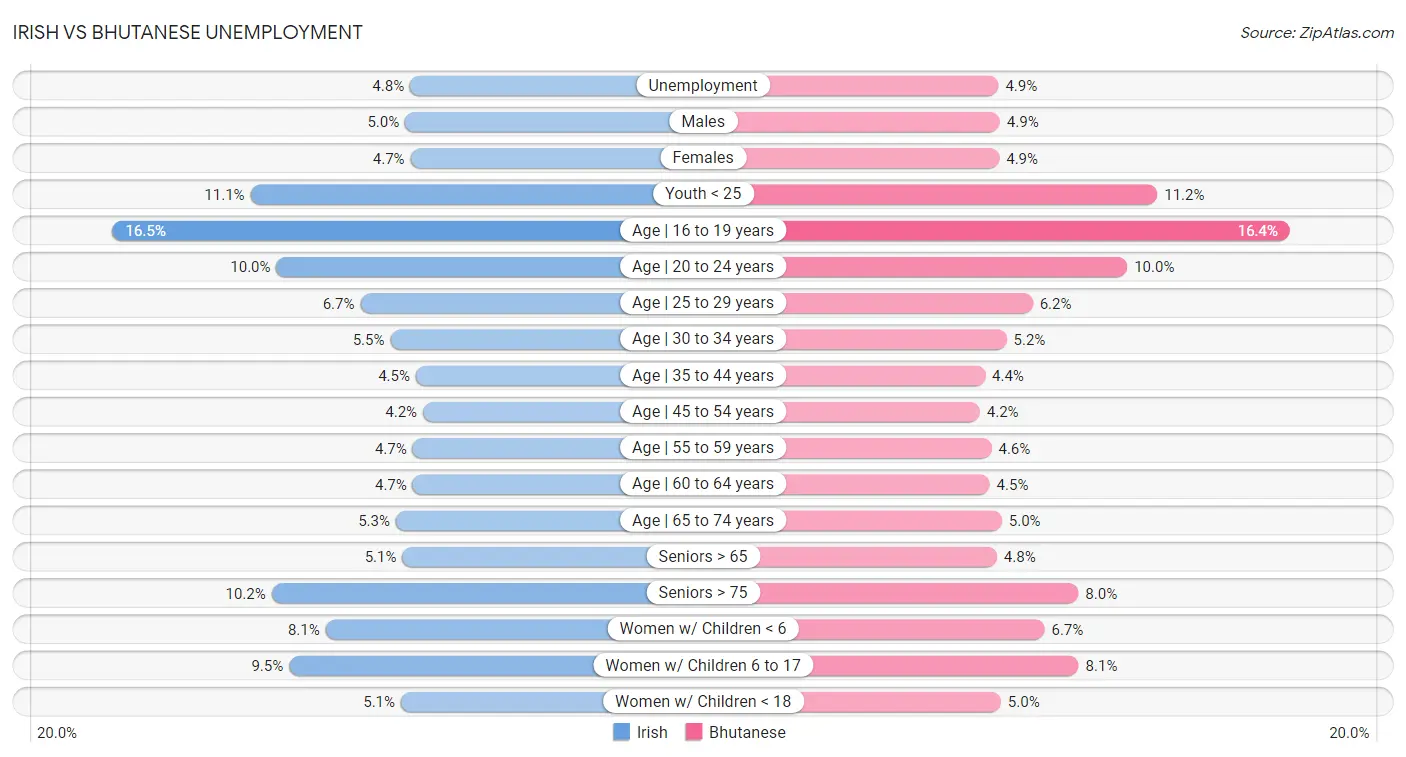
| Unemployment Metric | Irish | Bhutanese |
| Unemployment | Exceptional 4.8% | Exceptional 4.9% |
| Males | Exceptional 5.0% | Exceptional 4.9% |
| Females | Exceptional 4.7% | Exceptional 4.9% |
| Youth < 25 | Exceptional 11.1% | Exceptional 11.2% |
| Age | 16 to 19 years | Exceptional 16.5% | Exceptional 16.4% |
| Age | 20 to 24 years | Exceptional 10.0% | Exceptional 10.0% |
| Age | 25 to 29 years | Fair 6.7% | Exceptional 6.2% |
| Age | 30 to 34 years | Fair 5.5% | Exceptional 5.2% |
| Age | 35 to 44 years | Excellent 4.5% | Exceptional 4.4% |
| Age | 45 to 54 years | Exceptional 4.2% | Exceptional 4.2% |
| Age | 55 to 59 years | Exceptional 4.7% | Exceptional 4.6% |
| Age | 60 to 64 years | Exceptional 4.7% | Exceptional 4.5% |
| Age | 65 to 74 years | Good 5.3% | Exceptional 5.0% |
| Seniors > 65 | Excellent 5.1% | Exceptional 4.8% |
| Seniors > 75 | Tragic 10.2% | Exceptional 8.0% |
| Women w/ Children < 6 | Tragic 8.1% | Exceptional 6.7% |
| Women w/ Children 6 to 17 | Tragic 9.5% | Exceptional 8.1% |
| Women w/ Children < 18 | Exceptional 5.1% | Exceptional 5.0% |
Irish vs Bhutanese Labor Participation
When considering labor participation, the most significant differences between Irish and Bhutanese communities in the United States are seen in in labor force | age 16-19 (42.0% compared to 36.3%, a difference of 15.6%), in labor force | age 20-24 (77.4% compared to 75.4%, a difference of 2.6%), and in labor force | age > 16 (64.1% compared to 65.5%, a difference of 2.1%). Conversely, both communities are more comparable in terms of in labor force | age 25-29 (85.0% compared to 84.8%, a difference of 0.21%), in labor force | age 30-34 (84.7% compared to 85.0%, a difference of 0.33%), and in labor force | age 35-44 (84.4% compared to 84.7%, a difference of 0.33%).

| Labor Participation Metric | Irish | Bhutanese |
| In Labor Force | Age > 16 | Tragic 64.1% | Excellent 65.5% |
| In Labor Force | Age 20-64 | Poor 79.3% | Exceptional 80.2% |
| In Labor Force | Age 16-19 | Exceptional 42.0% | Fair 36.3% |
| In Labor Force | Age 20-24 | Exceptional 77.4% | Excellent 75.4% |
| In Labor Force | Age 25-29 | Exceptional 85.0% | Good 84.8% |
| In Labor Force | Age 30-34 | Average 84.7% | Excellent 85.0% |
| In Labor Force | Age 35-44 | Average 84.4% | Excellent 84.7% |
| In Labor Force | Age 45-54 | Fair 82.6% | Exceptional 83.5% |
Irish vs Bhutanese Family Structure
When considering family structure, the most significant differences between Irish and Bhutanese communities in the United States are seen in births to unmarried women (32.2% compared to 27.9%, a difference of 15.6%), divorced or separated (12.5% compared to 11.2%, a difference of 11.9%), and single mother households (5.8% compared to 5.3%, a difference of 10.1%). Conversely, both communities are more comparable in terms of currently married (48.9% compared to 48.6%, a difference of 0.49%), married-couple households (48.6% compared to 49.3%, a difference of 1.3%), and family households with children (26.8% compared to 27.3%, a difference of 1.7%).

| Family Structure Metric | Irish | Bhutanese |
| Family Households | Average 64.4% | Exceptional 65.9% |
| Family Households with Children | Tragic 26.8% | Fair 27.3% |
| Married-couple Households | Exceptional 48.6% | Exceptional 49.3% |
| Average Family Size | Tragic 3.10 | Excellent 3.25 |
| Single Father Households | Good 2.3% | Exceptional 2.1% |
| Single Mother Households | Exceptional 5.8% | Exceptional 5.3% |
| Currently Married | Exceptional 48.9% | Exceptional 48.6% |
| Divorced or Separated | Tragic 12.5% | Exceptional 11.2% |
| Births to Unmarried Women | Fair 32.2% | Exceptional 27.9% |
Irish vs Bhutanese Vehicle Availability
When considering vehicle availability, the most significant differences between Irish and Bhutanese communities in the United States are seen in no vehicles in household (7.4% compared to 8.7%, a difference of 17.2%), 4 or more vehicles in household (7.1% compared to 7.8%, a difference of 10.5%), and 3 or more vehicles in household (21.8% compared to 22.2%, a difference of 2.3%). Conversely, both communities are more comparable in terms of 2 or more vehicles in household (60.1% compared to 59.1%, a difference of 1.7%), 1 or more vehicles in household (93.1% compared to 91.4%, a difference of 1.8%), and 3 or more vehicles in household (21.8% compared to 22.2%, a difference of 2.3%).

| Vehicle Availability Metric | Irish | Bhutanese |
| No Vehicles Available | Exceptional 7.4% | Exceptional 8.7% |
| 1+ Vehicles Available | Exceptional 93.1% | Exceptional 91.4% |
| 2+ Vehicles Available | Exceptional 60.1% | Exceptional 59.1% |
| 3+ Vehicles Available | Exceptional 21.8% | Exceptional 22.2% |
| 4+ Vehicles Available | Exceptional 7.1% | Exceptional 7.8% |
Irish vs Bhutanese Education Level
When considering education level, the most significant differences between Irish and Bhutanese communities in the United States are seen in no schooling completed (1.4% compared to 1.8%, a difference of 25.3%), professional degree (4.4% compared to 5.4%, a difference of 23.4%), and doctorate degree (1.9% compared to 2.3%, a difference of 23.0%). Conversely, both communities are more comparable in terms of 12th grade, no diploma (93.0% compared to 93.0%, a difference of 0.040%), high school diploma (91.4% compared to 91.2%, a difference of 0.20%), and nursery school (98.6% compared to 98.2%, a difference of 0.40%).
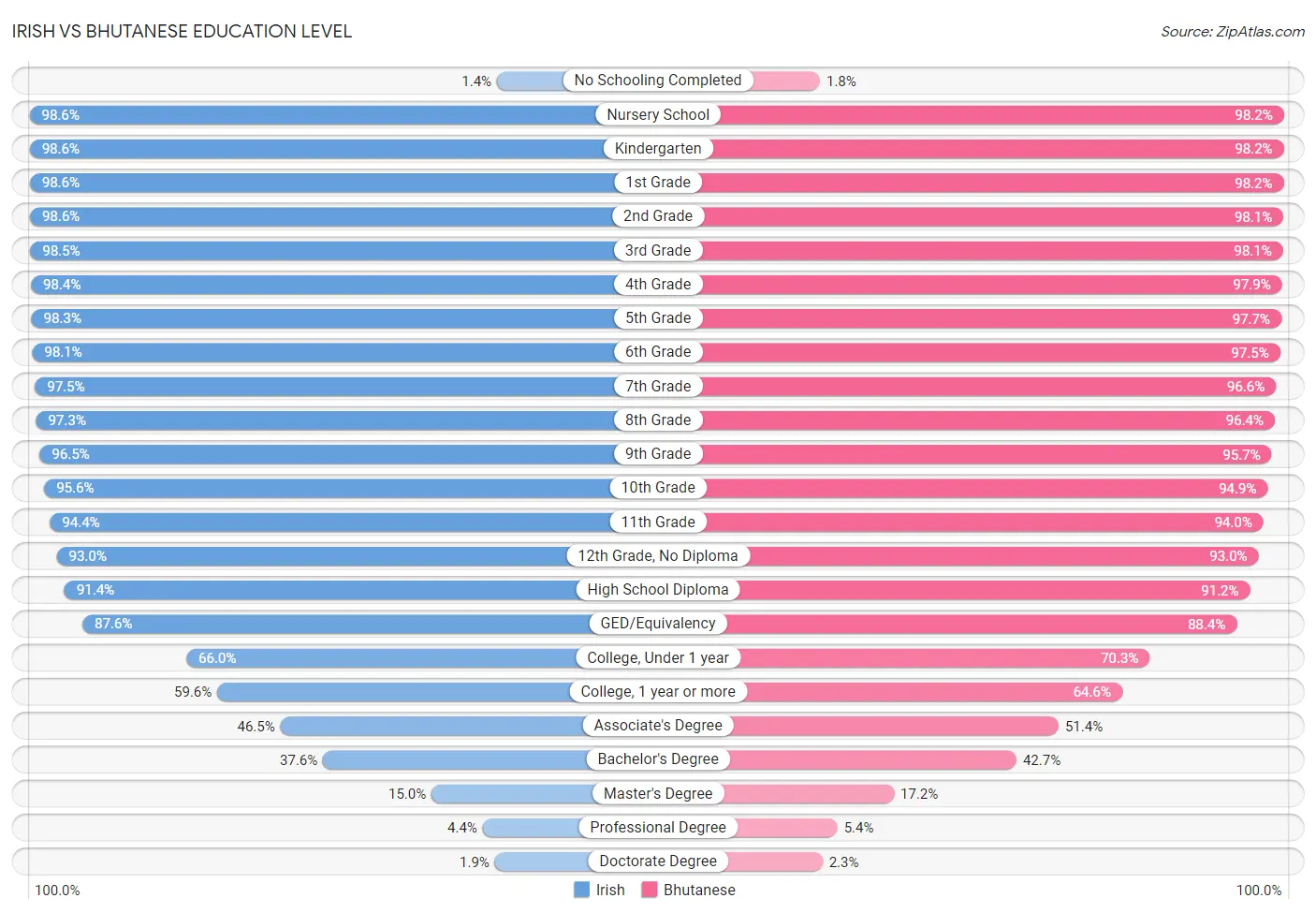
| Education Level Metric | Irish | Bhutanese |
| No Schooling Completed | Exceptional 1.4% | Exceptional 1.8% |
| Nursery School | Exceptional 98.6% | Exceptional 98.2% |
| Kindergarten | Exceptional 98.6% | Exceptional 98.2% |
| 1st Grade | Exceptional 98.6% | Exceptional 98.2% |
| 2nd Grade | Exceptional 98.6% | Exceptional 98.1% |
| 3rd Grade | Exceptional 98.5% | Exceptional 98.1% |
| 4th Grade | Exceptional 98.4% | Exceptional 97.9% |
| 5th Grade | Exceptional 98.3% | Exceptional 97.7% |
| 6th Grade | Exceptional 98.1% | Exceptional 97.5% |
| 7th Grade | Exceptional 97.5% | Exceptional 96.6% |
| 8th Grade | Exceptional 97.3% | Exceptional 96.4% |
| 9th Grade | Exceptional 96.5% | Exceptional 95.7% |
| 10th Grade | Exceptional 95.6% | Exceptional 94.9% |
| 11th Grade | Exceptional 94.4% | Exceptional 94.0% |
| 12th Grade, No Diploma | Exceptional 93.0% | Exceptional 93.0% |
| High School Diploma | Exceptional 91.4% | Exceptional 91.2% |
| GED/Equivalency | Exceptional 87.6% | Exceptional 88.4% |
| College, Under 1 year | Good 66.0% | Exceptional 70.3% |
| College, 1 year or more | Average 59.6% | Exceptional 64.6% |
| Associate's Degree | Average 46.5% | Exceptional 51.4% |
| Bachelor's Degree | Average 37.6% | Exceptional 42.7% |
| Master's Degree | Average 15.0% | Exceptional 17.2% |
| Professional Degree | Average 4.4% | Exceptional 5.4% |
| Doctorate Degree | Good 1.9% | Exceptional 2.3% |
Irish vs Bhutanese Disability
When considering disability, the most significant differences between Irish and Bhutanese communities in the United States are seen in disability age under 5 (1.7% compared to 1.2%, a difference of 45.0%), disability age 5 to 17 (6.2% compared to 4.9%, a difference of 27.1%), and disability age 35 to 64 (12.3% compared to 9.8%, a difference of 25.2%). Conversely, both communities are more comparable in terms of disability age over 75 (46.5% compared to 47.1%, a difference of 1.3%), cognitive disability (16.8% compared to 16.6%, a difference of 1.4%), and self-care disability (2.5% compared to 2.4%, a difference of 4.6%).
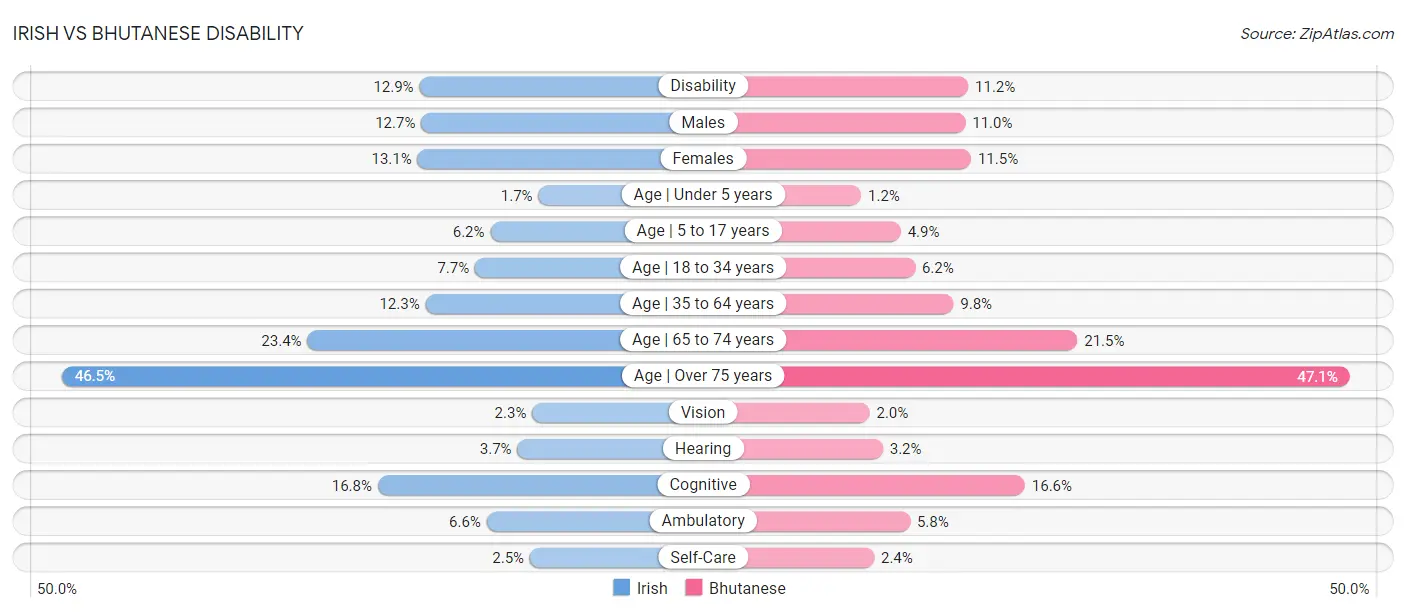
| Disability Metric | Irish | Bhutanese |
| Disability | Tragic 12.9% | Exceptional 11.2% |
| Males | Tragic 12.7% | Excellent 11.0% |
| Females | Tragic 13.1% | Exceptional 11.5% |
| Age | Under 5 years | Tragic 1.7% | Exceptional 1.2% |
| Age | 5 to 17 years | Tragic 6.2% | Exceptional 4.9% |
| Age | 18 to 34 years | Tragic 7.7% | Exceptional 6.2% |
| Age | 35 to 64 years | Tragic 12.3% | Exceptional 9.8% |
| Age | 65 to 74 years | Average 23.4% | Exceptional 21.5% |
| Age | Over 75 years | Exceptional 46.5% | Good 47.1% |
| Vision | Tragic 2.3% | Exceptional 2.0% |
| Hearing | Tragic 3.7% | Tragic 3.2% |
| Cognitive | Exceptional 16.8% | Exceptional 16.6% |
| Ambulatory | Tragic 6.6% | Exceptional 5.8% |
| Self-Care | Fair 2.5% | Exceptional 2.4% |